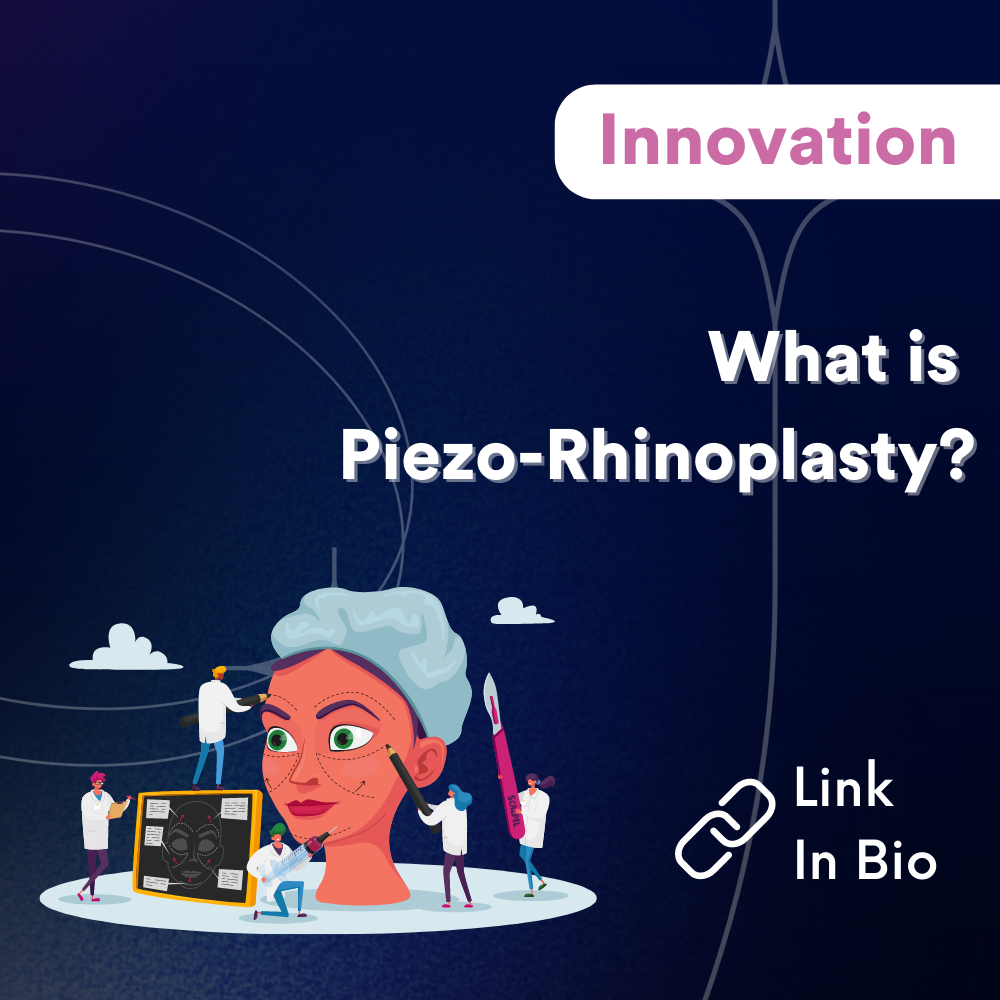Content by: Adish Joshi, Jasneet Kalra, Saanya Chhabra
Design by: Jasneet Kalra

Piezo rhinoplasty, also known as ultrasonic rhinoplasty, is an innovative technique used to reshape the nasal bones. Unlike traditional methods that involve a hammer and chisel, this approach utilises piezoelectric tools that emit ultrasonic vibrations. These vibrations allow for precise and controlled cutting of the bone while minimising damage to the surrounding soft tissues.
Traditional rhinoplasty techniques can cause trauma and harm to the tissues, leading to prolonged swelling and recovery periods. In contrast, piezo rhinoplasty’s ultrasonic vibrations enable targeted bone shaping without compromising the surrounding structures. The piezoelectric tools generate microvibrations designed specifically for bone cutting, offering advantages such as reduced bleeding, decreased postoperative swelling, and potentially faster recovery.
Piezo rhinoplasty has demonstrated itself as a safe and reliable method, producing positive immediate postoperative results. While long-term outcomes require further investigation, it has gained recognition among surgeons as a valuable addition for rhinoplasty procedures. This technique provides enhanced precision and may contribute to improved patient outcomes.
OLD VS NEW
Power-assisted rasps, burrs, and saws have been commonly used in rhinoplasty surgery with favourable outcomes. However, these tools have certain limitations, including their cost, longer operative time, risk of soft tissue injury, increased exposure, and difficulty in performing osteotomies (the controlled breaking of nasal bones). In recent times, surgeons have started utilising piezoelectric-powered ultrasonic instruments for managing the nasal bones and performing lateral osteotomies.
The advantage of these piezoelectric instruments is that they minimise soft tissue injury. They operate at a frequency of 25 to 29 kHz, which is suitable for cutting bone, while a frequency higher than 50 kHz is necessary to cut neurovascular structures. By utilising this specific frequency range, piezoelectric instruments can selectively act on bones and hard cartilage without causing harm to the surrounding soft tissues, such as the skin, mucosa, and delicate cartilages like the upper lateral cartilages (ULCs) and lower lateral cartilages.
One important benefit of using piezoelectric inserts (PEIs) is their ability to create precise fracture lines. Unlike traditional instruments, PEIs produce accurate fracture lines without the risk of radiating fractures. This adds to the safety and precision of the procedure, minimising complications associated with bone manipulation.
Overall, the use of piezoelectric-powered ultrasonic instruments in rhinoplasty surgery offers advantages such as reduced soft tissue injury, precise bone cutting, and improved control during osteotomies. These advancements contribute to safer and more effective nasal bone reshaping procedures.
METHOD
Piezoelectric surgery involves the use of piezoelectric vibrations generated by an electrically powered piezoceramic transducer. These vibrations are utilised with various tips to cut bone during surgical procedures.
The piezoelectric vibrations are used to emulsify and remove bony tissue while minimising thermal or mechanical injury to the surrounding tissue. The ultrasonic frequency is set at a low level, causing the metallic insert to oscillate and effectively cut through hard tissues such as bones and stiff cartilages. However, the soft tissues, including vessels, nerves, and mucous membranes, remain unaffected.
Water irrigation is provided through a distal port of the working tip, utilising a hydraulic circuit inside the hand-piece. A peristaltic pump controls the flow of water. Additionally, a foot pedal enables the surgeon to control various parameters such as power, mode, and irrigation.
Piezoelectric surgery, often referred to as PE, utilises various piezoelectric instruments, collectively known as PEIs. These instruments include saws, rasps, burrs, and scalpels, each serving specific purposes during the procedure.
ADVANTAGES
Precise Analysis: PEI allows surgeons to have extensive exposure and a clear view of the nasal structures, enabling them to make accurate diagnoses of bony deformities. The enhanced visibility provided by PEI helps surgeons better understand the anatomical variations and make more informed decisions during the procedure.
Safe Contouring: By using piezoelectric instruments, surgeons can selectively cut and shape bone without damaging surrounding tissues. The precise control offered by PEI reduces the risk of accidental fractures, minimising the potential for complications such as excessive bleeding or compromised healing.
Stability and Control: PEI enables stable osteotomies, which are the controlled fractures made in the nasal bones to reposition them. The ability to perform osteotomies under direct vision allows for precise mobilisation and control, resulting in more predictable and accurate outcomes.
Improved Surgical Outcomes: The precise nature of PEI can lead to improved aesthetic results. Surgeons can achieve the desired narrowing and symmetry of the bony dorsum with greater accuracy, resulting in a more harmonious and balanced nasal appearance.
Transparency in Upper Third Surgery: Traditionally, the upper third of rhinoplasty, involving the nasal bones, has been considered more challenging due to limited visibility. However, with PEI, the enhanced visualisation provided by the technique eliminates the “mystery” associated with this region. Surgeons can now have a clearer understanding of the bony structures and confidently perform necessary modifications.
This 35-year-old woman underwent osteotomies with piezoelectric instrumentation (PEI). This patient complained of a hump and a nose that appeared masculine. She had a high, C-shaped septal vertical deviation towards the left. Structural open rhinoplasty was performed with septoplasty and repositioning of the remaining bony septum. The results are shown preoperatively (A, D, G), 6 days postoperatively (B, E, H), and 1 year postoperatively (C, F, I) after PEI with osteotomies. Note the lack of bruising and swelling even with the extensive exposure to maxilla as well as osteotomies at 6 days

Conclusion
In conclusion, the adoption of PEI in rhinoplasty offers several advantages. With its precise analysis, surgeons can accurately diagnose bony deformities and safely contour the bones to achieve the desired narrowing and symmetry. The technique’s ability to provide extensive exposure allows for better control and stability during osteotomies.
References-
M. Robiony, L. Franz, F. Costa, A. Bianchi, C. Marchetti
Medicine
Plastic and Reconstructive Surgery Global Open
2016
M. Robiony, F. Costa, S. Sembronio
Medicine
Aesthetic surgery journal
2016
Gerbault O, Daniel RK, Kosins AM. Response to “Comments on ‘The Role of Piezoelectric Instrumentation in Rhinoplasty Surgery'”. Aesthet Surg J. 2016 May;36(5):NP189. doi: 10.1093/asj/sjw017. PMID: 27069245